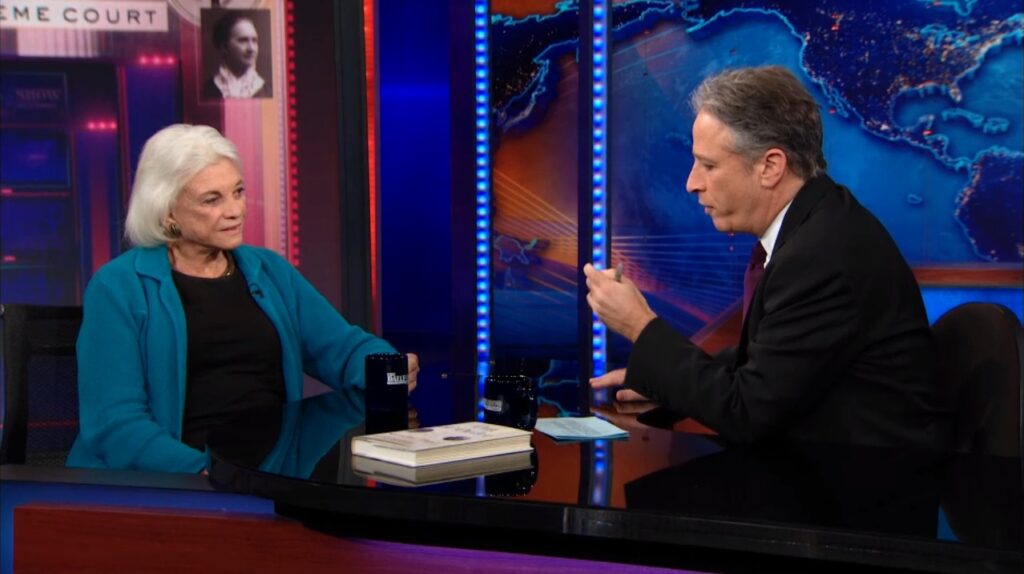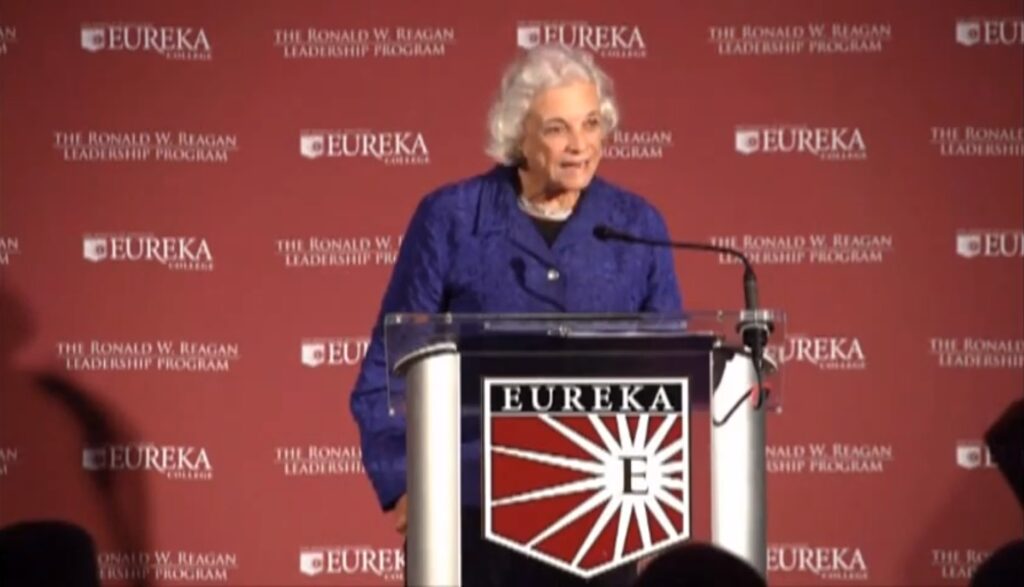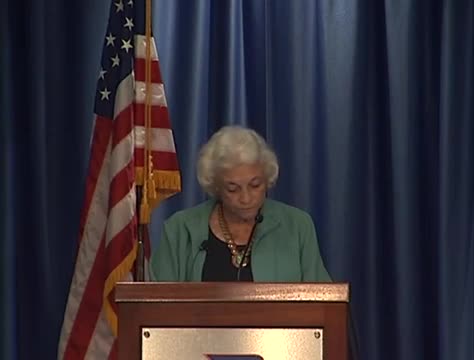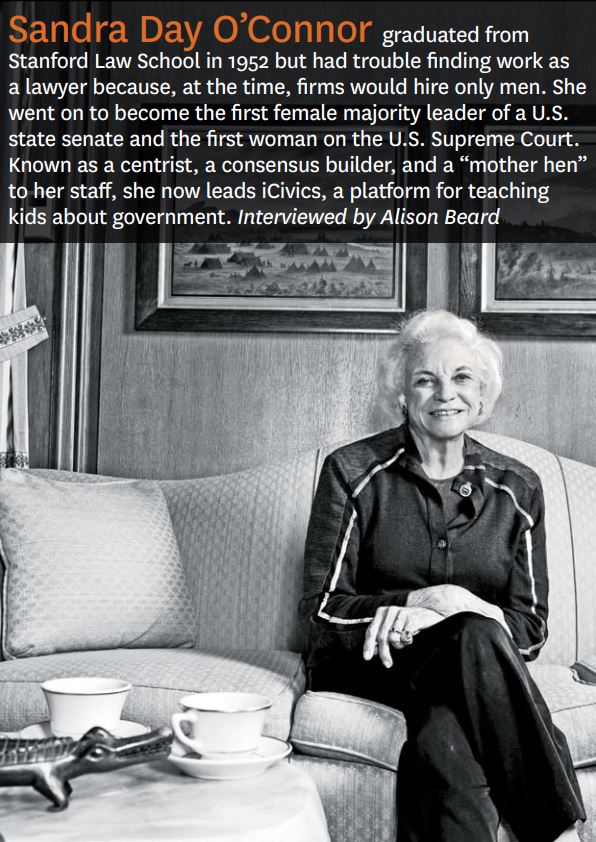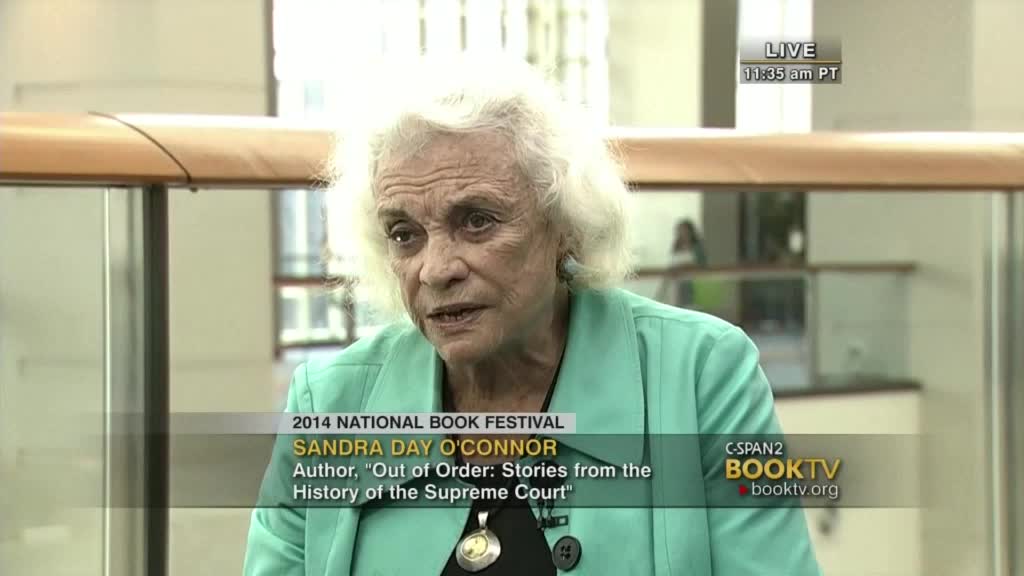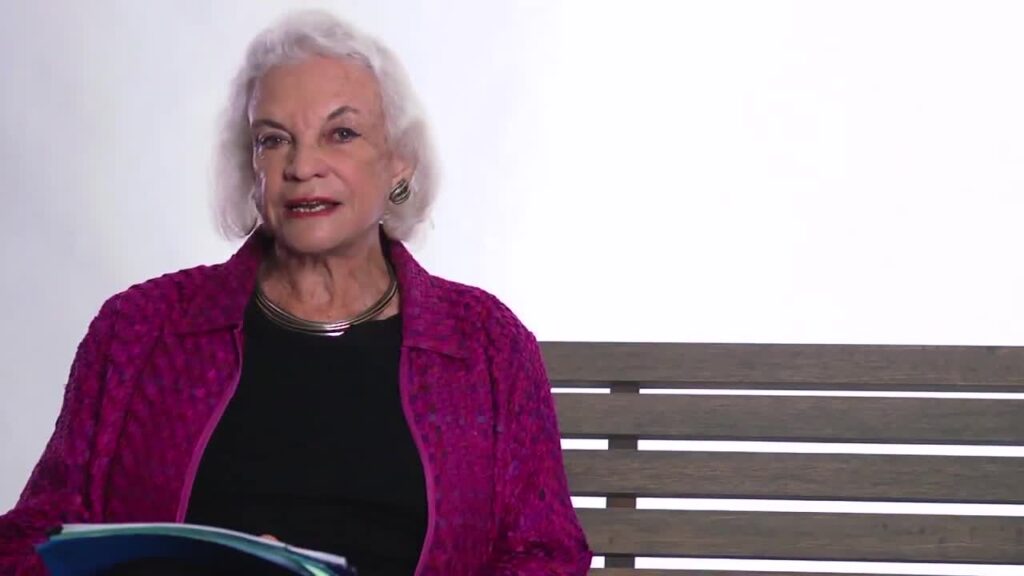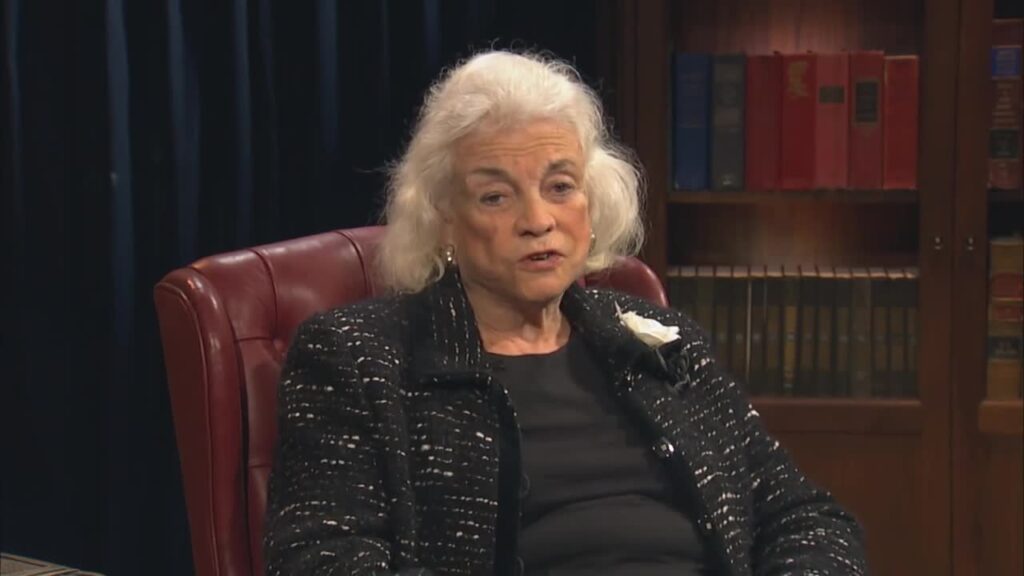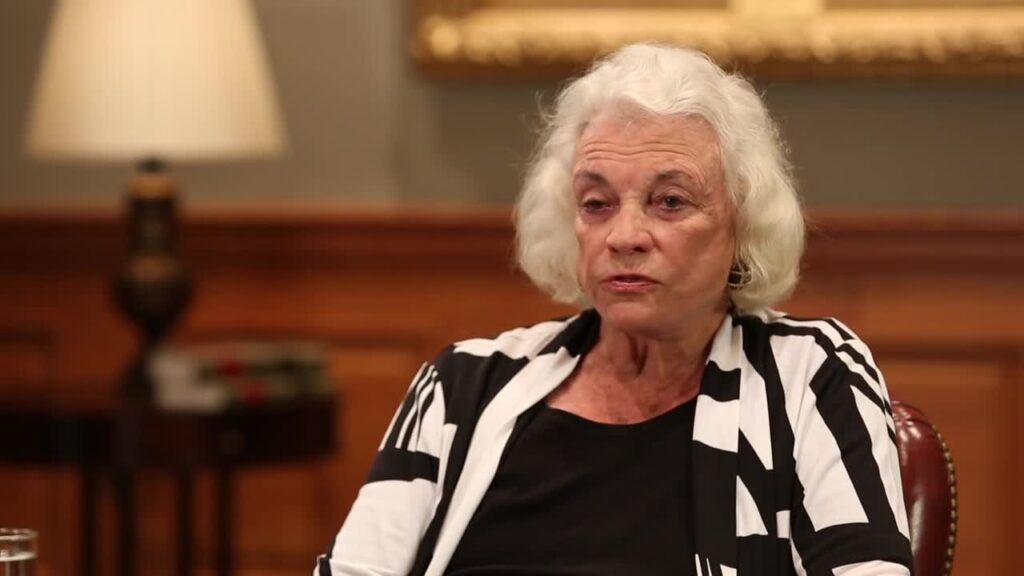Interviews, Speeches, Books and Writings
In this catalog, we invite you to explore Justice O'Connor's speeches, interviews, and writing throughout her career.
Jon Stewart
Nice to see you again. The book is called–
Sandra Day O’Connor
*Out of Order*.
Jon Stewart
*Out of Order*. What was your purpose in in this book and putting this particular book together?
Sandra Day O’Connor
Oh, just telling some of the stories about how the Court works and giving people a glimpse into some of the things.
Jon Stewart
It’s hard to imagine the pressure that a justice might feel when you’re dealing with, as we talked about earlier, some of the biggest issues of our day—
Sandra Day O’Connor
Yes.
Jon Stewart
Of racism and discrimination and—
Sandra Day O’Connor
Yes.
Jon Stewart
The franchise—
Sandra Day O’Connor
Right.
Jon Stewart
Does that weight, do you feel that when you’re deciding those cases?
Sandra Day O’Connor
You certainly do, because you really want to make the correct decision and bring some order out of our various statutes and constitutional provisions and the precedents of the Court itself. It’s hard sometimes.
Jon Stewart
You wrote, *Brown v. Board of Education* may be the most important decision.
Sandra Day O’Connor
It was very important to us as a nation.
Jon Stewart
When they made that decision, was it a difficult one, did people feel that they had overreached at that time?
Sandra Day O’Connor
You know, I don’t know the feeling of the justices who joined it. But that was a major decision. And many of them are. They affect us for years to come. And you really want to get it properly decided.
Convocation speech at Eureka College
Sandra Day O’Connor Thank you. Thank you very much, Mr. President. And I look forward to finding out just what those rights and apartments are. We’ll see. You can all help me find out. And thanks very much for the warm welcome and the kind introduction. It really is an honor to be here today at the alma mater of one of my heroes, former President Ronald Reagan, to receive an honorary degree and an honorary fellowship given in his name. The Reagan fellowship here at Eureka was created to encourage young people to lead lives of leadership and public service and this is an aim fitting to its namesake. President Reagan was one of our great contemporary leaders. And he was a public servant in the true sense of that word. I want to talk to you today a little bit about the meaning of public service, and about the ways both large and small that you can contribute to the public spirit of our great nation. And I want to talk to you as well, about President Reagan’s legacy, about the right to dream heroic dreams that he identified in his first inaugural address, and the quiet but the patriotism that he saw in our everyday lives. First, though, a story. When Ronald Reagan was campaigning for the presidency, he would he use, he didn’t think that he was doing quite well enough with the women’s vote. And he started saying that he would nominate a woman to fill the first vacancy on the Supreme Court during his tenure. Maybe he thought at that time, that it would help his poll numbers with women.
Acceptance speech for becoming the fifth Honorary Reagan Fellow at Eureka College
Sandra Day O’Connor
Thank you so much. It is really a delight for me to be able to come here to this place to the place where Ronald Reagan went to college, to receive the award, and to be part of this institution. And I’m just, I wouldn’t have traded this for anything. It’s really wonderful. Me, we all know how special Ronald Reagan was. And now I see part of what made him such. I’ve enjoyed today so much seeing and meeting a number of the students here at the college. I’ve been impressed by them. They’re wonderful. They’re a delight. And it just, this is a special place and you’re carrying out very good work in helping these students start their lives in a way that will serve as an example on a pattern for others to follow them in due course. I’m really happy to be here. Now I want to get to know my fellow honorary. Why do we call them fellows? fellows? Baron, get some more girls in there.
Anyway, it will be fun for the year in the years ahead to meet some of my colleagues and Miss BF. And I look forward to it. I’ve just welcomed the remarks that I’ve been able to hear while being here. And to meet the people I’ve met. I’ve always admired some of the things that are accomplished in this part of the world, your great companies that are here. We have a, why do we call it, the company that makes the tractors, Caterpillar? Caterpillar. I grew up on a ranch and we used to have a Caterpillar Tractor. And we had to get a new one occasionally. Not too often, they were too expensive.
In Search of a “Grand Unified Theory”: Thirty Years with the Endorsement Test
Sandra Day O’Connor Thank you so much. Thank you, our former national Secretary of Education, he did a great job in that position for the nation. And I really enjoy being in your state and in your beautiful city of Charleston. And being part of a program put on by this relatively new law school, you’re doing a super job. And I think this seminar that you put on, is going to register throughout the country, be sure you publish the talks that were given in your law review, or some similar publication, because I think the remarks have been very informative, very helpful, very thorough. So don’t let them get away, make sure they’re available for circulation nationwide. And I’m so glad to be here.
Now, I’m going to bore you with a little more about the endorsement principle, if you can stand it, you think you can for a few minutes. I’m so glad to be part of the program today. The establishment clause has been very much of interest to me, particularly when I served on the Supreme Court. And I am really pleased that the law review here and the law school has chosen to provide such a marvelous program in it on it today. It’s great. And I think the interest in the Establishment Clause is well deserved. religious pluralism lies at the very heart of the American political tradition. And I think it remains a major concern, as our country becomes ever more of our own, have larger and larger communities of people from widely different ethnic and religious backgrounds around the world. I mean,
Speech at the American Inns of Court National Symposium
Host
Justice Sandra Day O’Connor, thank you.
Sandra Day O’Connor
Thank you so much for a warm introduction, and thanks to the American Inns of Court Foundation for putting on this symposium. And I want to express appreciation to my fellow panelists for taking time to lend their expertise to the importance of civic education. Now, today, I’m just an unemployed cowgirl. But my life and my career off the ranch have spanned complex, contentious and crucial periods in our nation’s history. And I’ve been fortunate to have both witness some of that history and been part of some of it.
Growing up on a cattle ranch in America’s Southwest, shaped so much of what and who I am, and shaped values that still guide me. I do remain a cowgirl at heart. But other chapters in my life have also informed me and shape some of my beliefs. My experiences on the Supreme Court and following are what drove me to my present passion for, and commitment to, civic learning in America. But before getting into that, let me take you back to an earlier time and quite relates to this conversation.
When I graduated from Stanford Law School, I was engaged to be married to John. And he promptly got drafted, he’d been deferred. And we both like to eat. So one of us had to get a job. And that was me. I had done very well in law school, I was way up there and Law Review and all those things. And so I thought it wouldn’t be a problem. And there were at least 40 notices on the placement bulletin board at Stanford saying
Speech to the National Conference of State Legislatures
Sandra Day O’Connor
It’s really a treat to be here with you this year to open the National Conference of State Legislators—Legislatures, for the 2013 Legislative Summit.
And I thank you very much for welcoming me here today. As a former Arizona legislator, I really appreciate the chance to be among all of you, I know what you go through. And I have a lot of respect for the work that the National Conference of State Legislatures does to try to ensure quality and effectiveness of state legislative bodies, and the work that each of you do to ensure this in your own state. So thank you for being here today and letting me join you.
I’m going to talk about two things, things today that are near and dear to my heart In this connection. One is how do we get fair courts in our states? And the other is how do we increase civics education for our young people. Now, I’ve devoted a lot of my time since I retired from the Supreme Court to promote both of these concepts. And I’m going to talk first about fair courts and a few threats to that ideal. Then I’m going to talk briefly about how civics education can minimize threats to our system.
At the heart of the ideal of fair courts in our states, is the rule of law. And under the rule of law, we expect judges to follow the law as it is, not as it should be, or how we think it should be changed or even how the public thinks it should be.
Judges have to follow what in fact is the law at that time may have to decide the issue. And fulfilling
Interview with the National Conference of State Legislatures
Host
Justice O’Connor, what do you think the average reader will be most surprised to learn from your new book, Out of Order: Stories from the History of the Supreme Court?
Sandra Day O’Connor
Oh, it’s hard to say. I think for one thing, people generally don’t know that for a long, a long time in the Court’s history, the justices had to ride the circuit. They had to go around the country and sit on cases. And they weren’t sitting in Washington, DC all the time as they are now. And that was extremely challenging for the justices. None of them liked it. And it was very burdensome. It went on for a long time. And I think most people are surprised to learn it.
Host
When you were when you were doing the research on this things, did you ever think, “Wow, how did this institution survive with all of the, with all of the things that went on?”
Sandra Day O’Connor
I didn’t think that it had to survive, we had to have a Supreme Court cord. But the challenges in those days were so substantial, that it made it difficult to get justices. And to get good people, you need to have a work pattern that doesn’t just kill you. And that one almost did. So I think that’s the biggest surprise for people.
Host
You told us yesterday in the opening general session that too many Americans believe that justices are politicians with black robes, and that you advocate taking politics out of judicial selection. In a culture that seems to demand instant accountability from everyone in public life
Women and Leadership
Sandra Day O’Connor
Now, if I say–thank you, stop piping. It takes me a little while to get around these days. So I’m a little slow. I didn’t mean for it to extend the clapping period.
It’s wonderful to be here. And I’ve enjoyed all of it. And you ended up with some pretty terrific commentary, I must say, and Bonnie Mac of vain Hunter, I hate to follow her, because she’s too good. So that was a treat to get to hear her today. And thank you, David for the kind introduction.
Those of us who are part of iCivics are very appreciative of being here and being involved here at this university. Because I think that in the weeks and months and years ahead, maybe we can really achieve some things that matter in educational field. I think we can, and I’m enthusiastic about that. And as I’ve been pointing out for a while now, I’m just an unemployed cowgirl. At the same time I’m aware of the fact that my life and my career has spanned some complex and contentious and important periods in our nation’s history. It’s certainly involved, among other things, getting women in the work world in our country. And I’ve been fortunate to witness that history and to have been part of it. And growing up on a cattle ranch in the southwest shaped so much of who and what I am, and of the values that still guide me. I think I remain a cowgirl at heart, but other chapters in my life have also helped shape my beliefs.
My experiences on the Supreme Court and since are what has driven me to my current
Interview with Idaho Public Television
– Hello and welcome to “dialogue. ” I’m Marcia Franklin. In 1981, President Ronald Reagan made history when he nominated an Arizona judge, Sandra Day O’Connor, to the United States Supreme Court. The U. S. Senate would go on to confirm O’Connor by a vote of 99-0, making her the first woman to serve on the nation’s highest court. In her nearly 25-year career on the court, O’Connor would cast many deciding votes in high profile cases. She, though, has always taken a rather low profile when it comes to talking about those opinions. But that doesn’t mean she isn’t busy, and recently the 83-year-old retired justice was in Idaho.
>
– O’Connor was in Boise to receive an award from the Andrus Center for Public Policy, which was also hosting a conference on women and leadership. O’Connor, who grew up on a ranch in Arizona, drew comparisons between herself and Governor Andrus, who was raised in rural Oregon.
– Both Governor Andrus and I had early childhood homes without any electricity or indoor plumbing, a joy not everyone can say they had. Were it not for our careers in public service, we might just be an unemployed cowgirl or an unemployed lumberjack, who knows?
– It looked like O’Connor would also be an unemployed lawyer when she graduated from law school in 1952, because of the discrimination against women.
– When I graduated from law school, I tried very hard to find a job in my new legal profession. I was spurned time and time again because I was a woman and they weren’t going to hire a woman lawyer.
“Why Judges Wear Black Robes” in Smithsonian magazine
Justice Sandra Day O’Connor on Why Judges Wear Black Robes
The Supreme Court icon breaks down the tradition
By Sandra Day O’Connor
Smithsonian magazine,
November 2013.
The simple black judicial robe has been a part of my life for nearly four decades. I first wore one in 1975 when I became a trial judge in Arizona. When I was appointed to the Supreme Court of the United States, in 1981, I brought that same robe with me to Washington and wore it on my first day on the bench. Although I retired in 2006, I still wear a robe in my role as a “circuit-rider,” sitting frequently , as many retired justices do, on various federal Courts of Appeals across the country.
It is surprising to me how little we know about where this plain black judicial uniform comes from. Colonial judges in England wore robes, and the tradition took off on American soil as well. But English judges also wore colorful robes and ornate wigs—a tradition that was not adopted in the United States. Some speculate that the Supreme Court began with more colorful attire; the court’s official portrait of the first chief justice, John Jay, shows him in a robe of black and red with white borders. The story, perhaps apocryphal, is that Thomas Jefferson himself objected to such unnecessary pomp: As an ardent supporter of modest republican citizenship, Jefferson was against “any needless official apparel,” especially “the monstrous wig which makes the English judges look like rats peeping through bunches of oakum.” It is
“Life’s Work: An Interview with Sandra Day O’Connor”
Sandra Day O’Connor graduated from Stanford Law School in 1952 but had trouble finding work as a lawyer because, at the time, firms would hire only men. She went on to become the first female majority leader of a U.S. state senate and the first woman on the U.S. Supreme Court. Known as a centrist, a consensus builder, and a “mother hen” to her staff, she now leads iCivics, a platform for teaching kids about government.
You grew up on a ranch that straddled Arizona and New Mexico—a long way from Washington, DC, and the Supreme Court. How did that upbringing influence you?
Growing up on a ranch, you’re assigned certain tasks, and you’d darned well better do them and do them right. Everyone was expected to help and to do their best. I’ll tell you a little story. Once, when I was a teenager, the workers were rounding up the cattle in an area very far from the ranch headquarters. We had to get lunch to them, and the roundup cook for some reason wasn’t going to be there. So I got up extremely early, my mother and I fixed the lunch, and I got in a pickup truck alone to drive to the place where they were. I was going along, when all of a sudden I got a flat tire. So I stopped the truck and got out. I knew how to jack a car up—I’d seen it done—so I found the jack and did that. I worked so hard. Then I got the flat tire off and the spare tire on, put the lug bolts in tight, and got everything working again. But it took me a long time. By the time I got to the men, it was several hours
Interview in State Legislatures magazine
FOR THE RECORD Sandra Day O’Connor “My time as a state legislator was a wonderful experience.” A former two-term Arizona state senator, Sandra Day O’Connor was nominated to the U.S. Supreme Court by President Ronald Reagan in 1981 and was confirmed unanimously by the U.S. Senate. She became the first woman Supreme Court Justice and one of the most influential members of the court who was often the swing vote. She retired from the Court in 2006 and turned her energy to writing and civic education. Today, she is the author of five books, including Out of Order: Stories from the History of the Supreme Court, published this year. President Obama honored her with the Presidential Medal of Freedom in 2009. State Legislatures: What do you think the average reader will be most surprised to learn from your new book, Out of Order: Stories from the History of the Supreme Court? Justice O’Connor: I think people generally don’t know that for a long time in the Court’s history, the justices had to ride the circuit. They had to go around the country and sit on cases. And they weren’t sitting in Washington, D.C, all the time as they are now. That was extremely challenging for the justices. None of them liked it, and it was very burdensome. SL: When you were doing the research for your book, did you wonder how the Court survived with all the things that went on? Justice O’Connor: It had to survive. We had to have a Supreme Court. But the challenges in those days were so substantial that
Interview at Association for Supervision and Curriculum Development (ASCD) Conference
Jeff Curley
Thank you all for being here this morning, Sunday am St. Patrick’s Day weekends impressive show here in Chicago especially. My name is Jeff Curley. I’m co-founder of iCivics. And I have the pleasure of introducing Justice O’Connor this morning, and having a chance to have a question and answer with you all. Obviously, Justice O’Connor requires no introduction. So you can keep my remarks very brief and then let her take the floor. But Justice O’Connor was the first woman to serve on the United States Supreme Court,
Sandra Day O’Connor
but not the last.
Jeff Curley
Her incredible accomplishments are extraordinary particularly given the era in which she began her career. Sandra Day O’Connor was born in El Paso, Texas. Now let’s see if we have any Arizonans here. She, she grew up on her family ranch the Lazy B In Arizona
Sandra Day O’Connor
And New Mexico. And New Mexico. Lots of places to call home. You know the ranch was within both states. Yes. And the only reason I got to El Paso was there wasn’t any town near the lazy be no hospital. I was the first child. My mother thought it would be good to have a hospital. So off we went to El Paso and I ended up going to school in El Paso. So, so all the things you hear today, that might be kind of crazy. It’s because I went to school male pastor.
Jeff Curley
Well, when she left El Paso in 1946 she was accepted at Stanford University, where she earned her bachelor’s
C-Span interview on her book, Out of Order: Stories from the History of the Supreme Court
Host: We are pleased to be joined on set outside the history and biography room by former justice of the supreme court Sandra Day O’Connor. This is her fifth book, the history of the Supreme Court, “Out of Order.” Five books. When did you discover you enjoyed writing?
Sandra Day O’Connor: nothing changed, lots of things to write about and tell about.
Host: would be doing at the book festival? You are not talking about your book.
Sandra Day O’Connor: not really. I know jim billington at the wall street — my brother has a new book out. And so Jim told me I had to bring my brother so I said I would and that is why we are here.
Host: you are in conversation with alan. Your brother. What is his book about?
Sandra Day O’Connor: for a long time he had them in North Dakota where he could take these and keep them for a while. The federal government had the responsibility for them so he did that for quite a while. It was so simple. Host: let’s talk about out of water and some of the stories year. One of the first stories you tell is former chief justice John Marshall and Thomas Jefferson were related and did not like each other.
Sandra Day O’Connor: isn’t that amazing?
Host: was the relationship?
Sandra Day O’Connor: it was amazing that they didn’t like each other and it was so difficult to manage but they did.
Host: the *Marbury v. Madison* case was during President Jefferson’s tenure. Exactly what did that case establish?
Sandra Day O’Connor: I don’t know that today we say much of anything.
Remarks on the Uniform Law Commission
Sandra Day O’Connor The uniform law commission plays a very special role in the laws of this country. As all of you know, we have a national government, we have a National Constitution. But what it did was to bring together the separate states. And most Americans aren’t totally unaware of how complex our legal system is. And the reason it has worked fairly well, I think, is due in large measure to the existence and work of the uniform law commission. It’s interesting that at least four members of the Supreme Court have given some time to serve on the uniform state law commission. And I think the members of the Supreme Court are keenly aware of the role play by having uniform state laws in the areas in which otherwise there’d be total conflict. I was privileged to be a state senator in Arizona, from 1969 to 1975. And for part of that time, I was the senate majority leader. And during my time of service in the Arizona State Senate, we passed more than a dozen of the uniform law Commission Act. And I was very much aware of the work of the Commission. Without it, I don’t think my state could have or would have enacted the laws dealing with commercial transactions, issues affecting child custody and support of the handling of trusts and estates. And it could be very difficult, duplicative and costly, without the existence of uniform acts passed by the various state. Now, at the time I lived in Arizona, I had a former law school classmate who also lived in Arizona. His name was William
HON. SANDRA DAY O’CONNOR JUSTICE, U.S. SUPREME COURT An Interview with Marci A. Hamilton and Barbara Bennett Woodhouse
HON. SANDRA DAY O’CONNOR JUSTICE, U.S. SUPREME COURT An Interview with Marci A. Hamilton Paul R. Verkuil Chair in Public Law, Benjamin N. Cardozo School of Law Barbara Bennett Woodhouse…
Remarks on President Abraham Lincoln’s legacy for the National Constitution Center
Sandra Day O’Connor Good evening. And I’m sorry, I wasn’t able to join you in person for this exciting event. Although I can’t say I’m sorry to be spending this winter evening, in a warmer climate. I dedicate much my time working to teach our school children about the importance of civic knowledge, including the importance of our nation’s charter our Constitution. A few years ago, I was speaking to a large group of young people. My purse was sitting next to my chair. I’m told it was even trending on Twitter, on Twitter for a time, one of the students asked me what I kept in that purse. I told her that of course, I keep the usual sorts of things there, a wallet, Kleenex tissues, a compact. I also told her that one thing I never forget to include is a copy of the Constitution. And just like I never forget my copy of the Constitution, I also never forget that we need to care and learn about the whole constitution, not just the original articles drafted in Philadelphia, and the Bill of Rights ratified soon after, but also the later amendments, including the vital amendments that we’re celebrating here tonight, amendments that ended slavery that secured equality for every one of us, and expand it the right to vote. This is an important lesson to keep in mind tonight, as we celebrate Celebrate President Lincoln’s constitutional legacy, and in particular, his role in the ratification of the 13th amendment to our Constitution, as well as an over the next five years, as we celebrate
Interview at National Portrait Gallery
Sandra Day O’Connor
I wanted since I was the first not to be the last, and I wanted to do the job well, so would provide encouragement for women to serve in the future.
Unknown Speaker
When Justice Sandra Day O’Connor became the first woman to serve on the US Supreme Court, she had traveled a long road from the cattle ranch in the southwest where she was raised last major gender discrimination roadblocks in the beginning of her legal career.
Sandra Day O’Connor
I didn’t know there was a problem out on the ranch, there certainly wasn’t a problem. So I was unaware of any gender discrimination, if you will, was not in my scope of experience at all.
Unknown Speaker
When did you first become aware?
Sandra Day O’Connor
I don’t know probably much later in life when I tried to get a job.
Unknown Speaker
Were you surprised how limited the possibilities were when you graduated from law school?
Sandra Day O’Connor
I was shocked because I did very well in law school. I was way up here. And I assumed everything would be perfect. And it wasn’t I couldn’t get a job offer. And I was shocked by that.
Unknown Speaker
After graduating from Stanford Law School when she could not get a job as a lawyer at a law firm, she finally started working as a deputy county attorney in California, so to be nominated to the top court in the country almost three decades later.
Sandra Day O’Connor
Well, it was of course, a surprise that I was and it was very demanding because I had to put forward a demeanor

